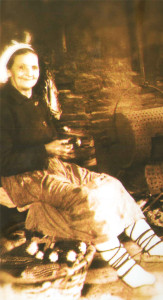
 The prime objective of the Urte-sasoiak collection is to highlight the ever-present tight connection in Euskal Herria between the traditional seasons of the year and a set of customs that still are very much alive.
The prime objective of the Urte-sasoiak collection is to highlight the ever-present tight connection in Euskal Herria between the traditional seasons of the year and a set of customs that still are very much alive.
This fourth booklet is dedicated to autumn. Autumn celebrations do not revolve around a major feast as happens during the rest of the seasons. The winter time Christmas cycle counts with fixed boundaries -it starts on Christmas Eve and ends on the day of Epiphany-, and the solstice stands as its central axis; the bulk of the summer festivities are centered on Saint John’s Day; and when winter comes to a close and spring begins, diverse traditional events and cultural expressions are attached to certain festive occasions (Saint Agatha’s Day, Carnival, and so on).
During autumn, on the contrary, there are no clearly defined dates in our calendar around which popular festivities converge. Nevertheless, according to some experts, a deeper study confirms that a number of autumnal rituals observed in the past and half forgotten nowadays, scattered vestiges of a pre-winter cycle, do subsist. Delving into these unwoven ends of warp and weft, we find celebrations of a religious nature, and practices and festivals tinged with a popular touch, but not concentrated around a clear guiding principle like happens with the rest of the seasons.
At this time of the year farming and shepherding chores acquire great relevance. It is harvest time at the farm, and the crops grown from the seeds sowed throughout the year provide their fruit; in fact, life in the olden days was highly dependent upon field crop yields (cereal, flax, maize, grapevines, apple trees…). The gathering of the harvest leads to subsequent undertakings and concerns (the treatment of wheat and maize from the time the ears are collected to when the grain is ground into flour, the penalties of flax fibre manufacturing, the production of wine or cider out of grapes or apples, and so on). Likewise, some of the farm animals grown find their last days at this time of the year -pigs, for instance-; their salt-cured meat is saved in wooden chests to be consumed in winter. Apples, walnuts, chestnuts, legumes… were carefully kept in the attic to later fulfill the needs of the household.
This abundance did not bring work on the farm to a halt. In those places were the traditional way of life prevailed, autumn was believed to be the true start of the year, because apart from taking care of the harvested fruits and crops, farmers had to initiate the groundwork to secure a good production for the following year, such as gathering seeds and arranging seedbeds.
 In September and October there are a number of festivities generally observed: the Nativity of Mary (8 September), the Feast of the Cross (14 September), Saint Michael’s Day (29 September), etc.
In September and October there are a number of festivities generally observed: the Nativity of Mary (8 September), the Feast of the Cross (14 September), Saint Michael’s Day (29 September), etc.
At the beginning of November, there are a couple of solemnities: All Saints’ Day (1 November) and All Souls’ Day (2 November). Those are days to remember the departed family members. Apart from the customs observed during the year in churches (symbolic graves, light offerings, and so on) and in cemeteries, specific rituals commemorated the deceased relatives.
Saint Martin’s Day is celebrated soon after (11 November). This saint has been honoured since time immemorial in our culture, and this feast is deeply rooted within our popular tradition and folklore by means of songs, tall tales and stories. This day marked the start of the pig slaughtering, txerribodak, time.
From then on, and except for a handful of modest celebrations (Saint Catherine’s Day, Saint Andrew’s Day, and others), all events are meant to finally lead us to the winter cycle starting on Christmas Eve and ending at Epiphany.
Here follows a calendar featuring the festivities observed during the autumn cycle and the repertoire of traditional musical pieces selected for the present book of songs.


